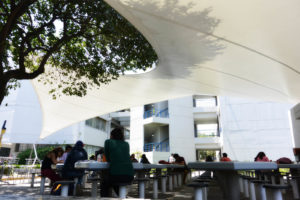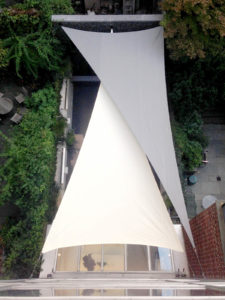
Building on a revitalized interest in city life, innovative, functional and beautiful fabric shade applications are updating urban environments in cost-effective style.
It wasn’t long ago that downtowns seemed more like ghost towns in many urban areas. The promise of larger lawns, less traffic and easily accessible malls drew people to the suburbs instead of toward the cities’ hubs that were their origins.
That’s all changing as cities pour money into urban revitalization in an attempt to restore downtowns to their former vibrant glory, and many of those renewal designs are featuring shade structures, awnings and exterior shades, fused with the best of historic architecture. And in addition to providing shade and shelter from the elements, they also act as important and inviting aesthetic elements.
“In the last 15 years or so, the urban renewal efforts have had a receptive audience as people, tired of the car-oriented lifestyle of the suburbs, are returning to urban cores and older urban neighborhoods,” writes Bill Adams in a September 2014 UrbDeZine post entitled “6 Common Mistakes Made By Cities and Towns in Urban Renewal.” Adams is founder and chief editor of the San Diego-based publication, which focuses on urban planning, design, architecture and historic preservation. He continues: “For more than any other reason, successful urban renewal depends on creating or restoring an environment that diminishes the primacy of the automobile and prioritizes walking, active transit, public transit, the natural environment and existing structures.”
A long-term focus
When properly planned and executed, shade structures fit perfectly into making those revitalizing goals a reality, something referred to as “destination architecture,” says Jacob Schwartz, owner of ITS (International Tension Structures), Phoenix, Ariz. “A nicely designed urban space is best complemented by an equally nice piece of fabric architecture,” he says. “In fact, often the fabric architecture we provide becomes the focus of that space and what draws people to the area.”

Schwartz points out that to be a part of successful urban solutions the fabric architecture needs to be designed with a long-term perspective and investment in mind. ITS recently completed a fabric architecture installation in Tolleson, Ariz., as a part of the city’s urban renewal initiative. The project was a redevelopment of an historic downtown area, which meant making improvements to the streetscapes, including lighting, sidewalks and landscaping. The tension fabric structure ITS designed and fabricated was a heavy steel structure covered with a white mosaic tile-inspired membrane to honor the town’s Hispanic and Mexican community.
“The structure was a bit of a hard sell because it was a big investment for the city,” Schwartz says. “In the end, everyone involved did a great job on the whole project, but without a doubt one of the highlights of conversation at the grand opening festival was how great the tension fabric structure turned out.”
The project’s success was due to good collaboration between the design team and the city, as well as the city’s dedication to making sure the project results would be longstanding, according to Schwartz. “These projects always turn out the best when they’re a collaborative design effort,” he says. “Cities are usually working off of really tight budgets, but they’re also usually willing to invest in themselves, and to us one of the keys to that is investing wisely in the architecture.”

At the intersection of history and ingenuity
One of the main challenges of creating tension structures for historic areas is making sure that the new structure contributes to the aesthetics of the existing architecture. Carpas Y Lonas El Carrousel S.A. de C.V., Mexico City, Mexico, has installed numerous tension structures in historic areas.
“Today, applications of freestanding shade sail models exemplify an architectural taste that can meld well with traditional models,” says Hector Mendoza Uribe, an architect with Carpas Y Lonas El Carrousel. He points out that there are also more options for materials, including mesh fabrics, as well as better design software, that make the structures have more widespread appeal as an architectural option.
Installations in historic areas are typically supervised by government historic preservation entities to ensure that the new structures don’t compete with the old. “We’ve experienced some restrictions and push-back at times, but we’ve always been able to work things out,” Schwartz says. “I think it’s just a result of good quality fabric architecture complementing good historic architecture. Although this is a fairly new discipline that’s still emerging, we’ve had great success blending old and new.”
Preserving the aesthetic
When the goal is to restore an urban area to its former historic aesthetic, awnings often come into play. Some townships and cities establish architectural review boards in lieu of landmark preservation organizations. “Their goal is often to unify the look of their properties,” says Michael Catalano, president of Capitol Awning Co., Jamaica, N.Y. “In most of these kinds of cases awnings with lights are not acceptable, and they often don’t want to use vinyl products because they’re trying to replicate a historic awning. In some cases, however, you can get them to use a high-grade vinyl if it looks like fabric.”
New York City is full of landmark districts, and landmark preservation, though it’s been around for decades, is expanding, according to Catalano. “They’re doing it right, I think,” he says. “They’ve got a list of guidelines, which makes it easier to get approval on what we call a staff level. Store owners empower their staff to make decisions up to a certain point, and it’s just a matter of complying with the preservation requirements.”
Schools and budgets
Although people might typically think of store fronts, streets and parks when they think of renewing urban areas, schools also factor prominently into the equation. And because governments are often encouraging—or mandating—shade and shelter for schools, financing for them is available. “Last year our government started a campaign where all primary and secondary schools in the country [Mexico] should have shade structures in the yard to protect the students from UV rays,” Uribe says. “This is creating a large economic stream in the canvas sector financed by the government.”

Shade planning for schools in the United States is also gaining momentum, and not only in the southern states. Capitol Awning finished a project in December 2014 for a public school for gifted children in Manhattan, to incorporate 24 shade sails on a 15th-story rooftop garden of an existing structure. “I’m not sure if it was the case for this project, but there are some laws on the books at a federal level that say schools are supposed to have a certain amount of shade on their playgrounds as a skin cancer prevention initiative,” Catalano says. “We attached the sails to the existing structure and had to have them engineered to make sure we weren’t going to overstress the structure by adding the wind and snow loads of the sails to them.”
Although it’s now finished, the project was stalled for a few months due to budget issues, which Catalano says is often the case with these types of projects. “The architect designed something that would be roughly 125 percent more than what the client had budgeted,” he says. “That’s an issue we run into with government agencies and municipalities. They want the moon but don’t necessarily have the budget for it.”
Catalano reviewed the original design, which called for reinforcing the structure beyond what was necessary. He had his engineer assess it and was able to save the school board $7,000 by modifying the design, which included nixing some high-end custom hardware the architect wanted to use and reinforcing the edges of the shade cloth instead of using cables to stabilize it. Getting the decision made to revise the plans meant Catalano had to explain the compromise to the school board and ask members to convey their decision to the architect.
“I ended up calling the school board and explaining that by modifying the design in these ways we could get the budget back on track,” he says. “I also had to explain to them that they had to be the ones to tell the architect that. Sometimes architects are unwilling to deviate from their original designs, and the only way to counter that is to have the client tell them they can’t afford it.”

Energy efficiency in style
Exterior shades have been popular in Europe for a long time, but in the United States, designing buildings with exterior shade systems as part of the building system is just starting to gain traction.
“We do all types of shades, but the newest and most exciting are the exterior shades,” says Neil Gordon, CEO and president of InSync Solar, Chestnut Ridge, N.Y. “It’s a wonderful way of being energy efficient, and it does a lot for the aesthetics of a building. It’s a very clean look and architectural element.”
Gordon likens exterior shade systems to a fourth skin. “Our skin is the first skin; our clothing is the second; the walls of the building and windows are the third; and the exterior shades are the fourth,” he says. “Major architects are using these systems all over the world to reduce solar heat gain.”
With an interior shade you can block 50 percent of solar heat gain, but with an exterior shade you’re blocking 85 percent of heat gain from entering the space, according to Gordon. In terms of preservation and urban renewal, that type of energy efficiency has a significant impact on cities trying to improve sustainability. “We use the same fabrics they use for other fabric architecture applications,” Gordon says. “We use several fabrics but probably use Ferrari Soltis® 92 and 86 the most, because not only are they robust and durable but the edges don’t fray when you cut the fabric, so you don’t have to heat-seal the ends.”
Consolidating communities
While revitalizing existing urban areas is a strong and continuing trend, some cities are choosing to develop new construction: centralized urban landscapes that include restaurants, hotels, boutique-type shops, condos and single-family homes. “These consolidated communities are on the urban periphery,” says John Douds, vice president of southeastern sales for FabriTec Structures, Dallas, Texas. “We put up three Teflon®-coated fiberglass shade structures in a place called Avalon Development in Alpharetta, Ga. The structures provide ambiance and a focal point, as well as providing shade.”
FabriTec is currently working on a project that is as much a work of art as it is a shade provider, in the Cortex Innovation Community in St. Louis, Mo. The community is a 200-acre innovation hub and technology district integrated into historic residential neighborhoods that are surrounded by universities, medical centers and cultural and recreational areas. The 2,500-square-foot shade structure is covered with a PVC membrane and signifies creativity and innovation—the foundation of the community’s ideals. “The structure will be installed in the park that ties everything together,” Douds says. “The function of the piece, more than anything, is to be an iconic feature in the center of the community.”
There are countless ways to revitalize urban communities using shade structures. But the common denominator seems to be that unique combination of function and aesthetics, executed as long-term performance solutions. More and more, communities are turning to textiles to create these solutions, creatively and cost-effectively.
Sigrid Tornquist is a writer and editor based in St. Paul, Minn.
 TEXTILES.ORG
TEXTILES.ORG


